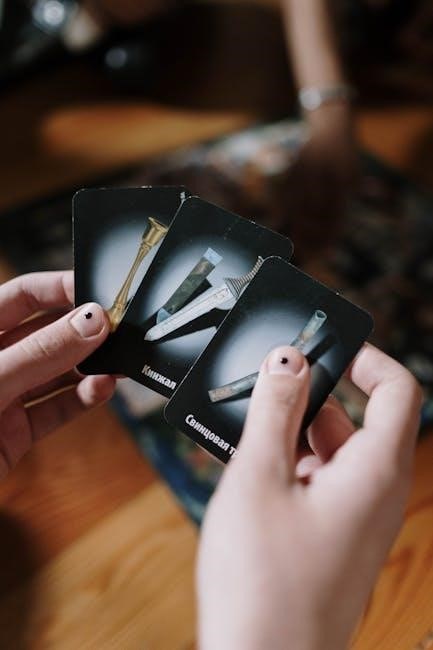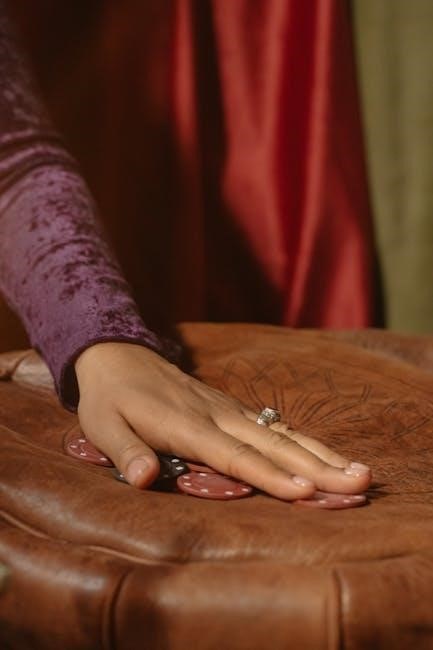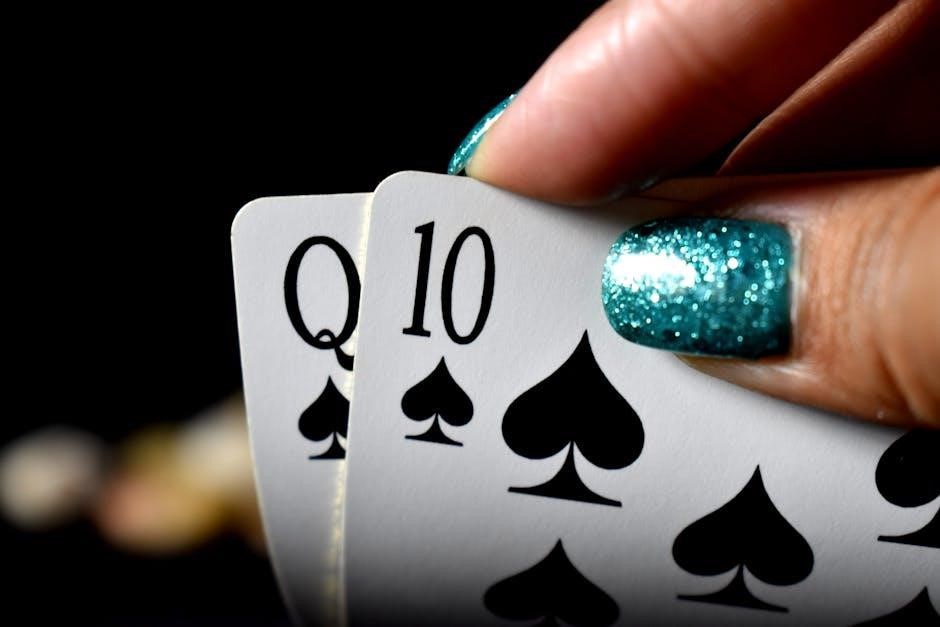Hand, Knee, and Foot is a popular, strategic card game based on Canasta, known for its unique gameplay and emphasis on teamwork. It’s enjoyed by many for its challenging and social nature.
Overview of the Game
Hand, Knee, and Foot is a dynamic and engaging card game that combines elements of strategy and luck. It is a variation of Canasta, played with multiple decks of cards, and is designed for teams of 4 to 8 players. The game involves three sets of cards for each player: the Hand, Knee, and Foot, each with a specific number of cards. The objective is to meld cards into valid sets or runs, aiming to be the first team to empty all their hands. Each round consists of strategic plays, including drawing cards, forming melds, and discarding unwanted cards. The game rewards teamwork and skill, with scoring based on completed melds and penalties for unplayed cards. Jokers and wild cards add an extra layer of complexity, while bonuses for special combinations like Canastas (seven-card melds) make the game even more exciting. With its unique structure and competitive nature, Hand, Knee, and Foot is a favorite among card game enthusiasts.

General Rules and Setup
Hand, Knee, and Foot involves 4-8 players in teams, using multiple decks of cards. Each player receives three sets of cards: Hand (15), Knee (13), and Foot (11), creating a structured start.
Number of Players and Teams
Hand, Knee, and Foot is typically played with 4 to 8 players, divided into teams of two to four. The game is highly flexible, accommodating various group sizes while maintaining its dynamic nature. Teams work collaboratively to discard all their cards, emphasizing coordination and strategy. For larger groups, additional decks of cards are used, ensuring each player has enough cards to form melds. The number of decks required increases with the number of players, usually one more deck per player, including jokers. This setup ensures the game remains balanced and engaging, regardless of the number of participants. The team-based structure fosters camaraderie and strategic planning, making it a popular choice for social gatherings and competitive play alike.
Card Decks and Initial Deal
In Hand, Knee, and Foot, the number of decks used depends on the number of players. For example, with 4 players, 5 decks (including jokers) are used. Each deck contains 54 cards, including jokers, which act as wild cards. The cards are thoroughly shuffled and dealt into three separate piles for each player: the Hand, Knee, and Foot. The Hand consists of 15 cards, the Knee has 13 cards, and the Foot contains 11 cards. The remaining cards form the draw pile, with the top card turned over to start the discard pile. The dealer is determined by drawing cards, with the highest card dealer distributing the cards. This setup ensures a balanced and structured start to the game, allowing players to strategize from the outset. The initial deal is crucial as it sets the foundation for the gameplay and melding process.

Melding and Card Combinations
Melding requires 3-7 cards of the same rank. Jokers act as wild cards. Forming valid combinations is key, with bonuses awarded for successful melds and strategic plays.

Valid Melds and Minimum Requirements
A valid meld consists of 3-7 cards of the same rank, such as three Kings or five 7s. The minimum requirement to start a meld is three cards. Each player must have at least one meld to begin laying down cards. Wild cards, including Jokers, can substitute for any rank but cannot be used in a natural meld. A team must meet the base requirement of melding before any additional cards can be added. A Canasta, a meld of seven cards, awards a bonus. Players must declare the type of meld they are laying down. If a player has Jokers left in their hand at the end, they incur a 50-point penalty per Joker. Understanding meld rules is crucial for strategic gameplay and maximizing points.
Role of Jokers and Wild Cards
Jokers and wild cards play a significant role in Hand, Knee, and Foot, adding flexibility to gameplay. Jokers are considered wild and can substitute for any rank to complete a meld; However, they cannot be used to form a natural meld (without wild cards). Each Joker left in a player’s hand at the end of the game incurs a 50-point penalty. Wild cards can be strategically used to complete or extend melds, but they must be clearly declared when played. Players must ensure wild cards are used wisely, as their improper use can lead to penalties. The ability to incorporate wild cards enhances the game’s complexity and requires careful planning to maximize their value while minimizing potential penalties.

Gameplay and Strategy
Hand, Knee, and Foot requires strategic planning and teamwork. Players must carefully manage their hands, use wild cards effectively, and coordinate with partners to achieve victory. Proper timing is key.
Playing the Hand, Knee, and Foot
Players begin by drawing cards and forming melds. The game starts with the hand, followed by the knee, and finally the foot. Each player must play through their hand before moving to the knee, and only after completing the knee can they access the foot. Team coordination is crucial, as players must work together to empty all cards. Wild cards, such as jokers, can substitute for missing cards but carry penalties if left unplayed. The game progresses with players drawing cards, forming valid melds, and strategically discarding to minimize points. Proper timing and communication with teammates are essential to maximize scores and achieve victory.
Going Out and Winning the Game
Going out in Hand, Knee, and Foot requires a player to meld all their cards, including those in the hand, knee, and foot. To go out, a team must meet specific conditions, such as having a base meld of seven cards and ensuring both players on the team are in their foot. A player must ask their partner for permission to go out, and the partner’s decision is final. If successful, the team scores points for their melds and bonuses, such as Canastas (seven-card melds) and red threes. Unplayed cards, including jokers, incur penalties. The game ends when one team goes out, and the team with the highest score wins. Proper strategy and teamwork are essential to achieve victory and maximize points.

Scoring System
Points are awarded for melds, with bonuses for Canastas (seven-card sets) and red threes. Penalties apply for unplayed cards, including jokers, which can significantly impact the final score.
Points for Melds and Bonuses
Points in Hand, Knee, and Foot are awarded based on the value of cards in valid melds. A three-of-a-kind earns 500 points, while a four-of-a-kind grants 1,000 points. Five, six, and seven-card melds (Canastas) award 2,000, 3,000, and 5,000 points, respectively. Each red three is worth 500 points if melded, and bonuses are given for completing multiple Canastas. Jokers carry a 50-point penalty if left unplayed. Points for melds are cumulative, and teams aim to maximize their score by forming high-value combinations. Strategic use of wild cards and timely melding can significantly boost a team’s score, making the game both competitive and rewarding. The scoring system adds depth and excitement, encouraging players to plan meticulously and aim for high-value plays.
Penalties for Unplayed Cards
In Hand, Knee, and Foot, penalties are imposed for any unplayed cards remaining in a player’s hand at the end of the game. Each joker left in a player’s hand incurs a 50-point penalty. Additionally, all unplayed cards in a player’s hand are scored against them, with face cards (Kings, Queens, Jacks) and Aces worth 20 points each, wild cards (jokers) worth 50 points, and number cards valued at their face value. The total penalty is the sum of all unplayed cards. This rule emphasizes the importance of strategic planning and timely melding to avoid costly penalties. Teams must carefully manage their cards to minimize losses, as these penalties can significantly impact the final score; The penalty system adds an extra layer of challenge and strategy to the game, encouraging players to aim for complete card depletion.
Hand, Knee, and Foot is a dynamic and engaging card game that combines strategy, teamwork, and skill. Its unique structure, involving three sets of cards, offers a challenging yet rewarding experience for players. The game’s emphasis on melding, penalties for unplayed cards, and bonus points for Canastas makes it a favorite among card game enthusiasts. Whether played in teams or individually, Hand, Knee, and Foot encourages strategic thinking and social interaction. With its versatile rules and adaptability to different player numbers, it remains a popular choice for gatherings and casual gameplay. For those looking to master a game that blends luck with skill, Hand, Knee, and Foot is an excellent option to explore and enjoy.
